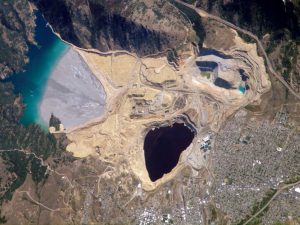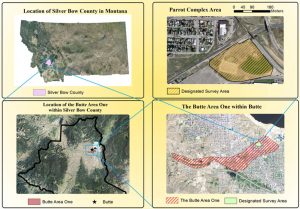14 December 2016
Magnetic fields help target buried mine waste for removal
Posted by dgaristo

A satellite view of Berkeley Pit and Yankee Doodle tailings pond in Butte, Montana. The pool is the former site of a massive copper mine and is just one remnant of Butte’s extensive mining history.
Credit: NASA.
By Emma Hiolski
Butte, Montana made national headlines last month after thousands of snow geese died in the toxic and acidic waters of the Berkeley Pit. The large, deep pool is the former site of a massive copper mine and is just one remnant of Butte’s extensive mining history.
Local organizations are trying to deal with some of Butte’s leftover waste from old mines and smelters but have been stymied by a problem: they can’t access the toxic waste because it is topped by a hardened layer of slag. Slag, a cement-like mixture of rocks and minerals left over after ore extraction, was often dumped as a heated, fluid concoction that hardened as it cooled. When smelters dumped slag over the remaining toxic slurry of water and particles known as “tailings”, the materials were cemented under a bricklike crust. Remediation specialists, who specialize in getting rid of toxic waste, can’t act before determining the size and depth of a slag pile.
But a new measurement method using magnetic fields has been able to provide quick and efficient measurements of the size and depth of slag piles at certain locations. The method could help remediation specialists with the remaining slag piles in Butte Area One—a sub-site of the greater Butte Federal Superfund environmental cleanup site—expediting cleanup in this critically contaminated region.
Chau Ha, a geophysical engineering undergraduate at Montana Tech in Butte, presented the results of his new method at the 2016 American Geophysical Union Fall Meeting in San Francisco. Ha, the first undergraduate student from Montana Tech to attend AGU, decided to tackle the problem of the slag pile to aid local remediation efforts, he said.
“The ground in Butte Area One was highly contaminated, and the [Water and Environmental Technologies] company was trying to clean up the tailings beneath the slag bodies,” Ha said. “But because the slag body is on top of the tailings, they were not able to do that without knowing the exact volume and thickness of the slag bodies.”
Ha and his colleagues at Montana Tech used three geophysical measurement methods to assess electromagnetic, gravitational and magnetic properties of the slag to find the most accurate means for determining the margins and thickness of a slag pile within Butte Area One. They were looking for a distinct contrast in the geophysical properties of the slag pile compared to the surrounding soil.

A map of the study location within Montana, Silver Bow County and the city of Butte.
Credit: Chau Ha.
The scientists’ first approach tested the electrical conductivity of the subsurface layer of soil and slag. However, both conducted electrical currents equally well, which prevented the researchers from distinguishing between the slag and neighboring soil. Measuring minute gravitational anomalies also yielded no apparent difference between slag and soil.
A proton magnetometer ultimately provided the best solution. Ha found that measuring the small variations in the magnetic field of the slag pile provided a clear picture of its margins and its depth in subsurface soil. This is likely because the metallic slag material, when it was dumped in the early 1900s, became magnetized by the Earth’s magnetic field and aligned with the North Magnetic Pole. After the slag cooled and hardened, its magnetic alignment was locked in, while the surrounding soil fluctuated over time with changes in Earth’s magnetic field. This created a clear difference between the slag and its surroundings.
Ha then constructed a 3-dimensional model of the slag pile based on the magnetism measurements and then used a fourth geophysical survey method—seismic profiling—to confirm that the magnetic data was correct. Seismic profiling uses sound waves to compare the density of various materials beneath the ground. This method also provided a clear picture of the slag pile boundary and depth, though it took considerably longer than the magnetic field measurements.
This data finally allowed Ha to calculate the volume of the slag pile, a total of 93,500 cubic meters (122,000 cubic yards), a volume equivalent to 12,200 cement trucks. This critical information will be needed prior to hiring a contractor to remove the slag pile. In the future, magnetic field measurements can help identify the margins and thickness of other slag piles in the region.
—Emma Hiolski is a graduate student at the UC Santa Cruz Science Communication Program. You can follow her on Twitter at @EHiolski










 GeoSpace is a blog on Earth and space science, managed by AGU’s Public Information staff. The blog features posts by AGU writers and guest contributors on all sorts of relevant science topics, but with a focus on new research and geo and space sciences-related stories that are currently in the news.
GeoSpace is a blog on Earth and space science, managed by AGU’s Public Information staff. The blog features posts by AGU writers and guest contributors on all sorts of relevant science topics, but with a focus on new research and geo and space sciences-related stories that are currently in the news.